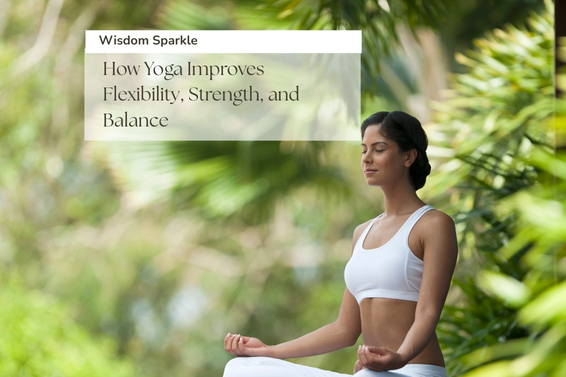
When most people think about yoga, the first thing that comes to mind is stretching or bending into different poses. And yes, yoga does involve stretching—but it’s much more than that. Yoga is a practice that helps your body, mind, and even your daily life. It makes you flexible, builds strength, and improves your balance in ways you might not even realize.
The beauty of yoga is that it’s not just for athletes or super-fit people. Anyone—whether young or old, beginner or experienced—can do yoga and feel its benefits. You do not need pricey equipment, a fancy gym membership, or a lot of free time. All you need is a mat, some space, and the willingness to try.
Yoga is gentle, but powerful. It doesn’t force you to push your body too hard; instead, it encourages you to listen to yourself, breathe deeply, and grow at your own pace. Over time, you’ll notice how everyday movements—like walking, sitting, or even standing tall—become easier and more natural. That’s because yoga works on both the small and big muscles of your body, while also calming your mind.
In this blog, we’ll explore how yoga improves flexibility, strength, and balance in a simple way. By the end, you’ll understand why yoga has become one of the most popular forms of exercise and self-care all around the world, and why so many people continue to practice it for a lifetime.
Yoga and Flexibility
Why Flexibility Matters
Flexibility isn’t just about touching your toes. It is all about how easily your muscles and joints move. When you’re flexible, your body feels lighter, your movements smoother, and you’re less likely to get injured doing daily tasks.
For example:
- Bending to pick something off the floor.
- Reaching overhead to grab a box.
- Sitting for long hours without stiffening up.
Without flexibility, these simple tasks can feel uncomfortable or even painful.
How Yoga Builds Flexibility
Yoga poses (also called asanas) gently stretch your muscles. Unlike quick stretches, yoga asks you to hold a pose for several breaths. This allows your muscles to relax and extend. Over time, your body adapts, and you notice more range of motion.
Some flexibility-focused yoga poses include:
- Downward Dog – stretches hamstrings, calves, and shoulders.
- Cobra Pose – opens the spine and chest.
- Seated Forward Bend – improves hamstring flexibility.
- Butterfly Pose – stretches hips and thighs.
Benefits of Flexibility Through Yoga
- Less stiffness in muscles and joints.
- Improved posture.
- Easier recovery after workouts.
- Reduced risk of injury in sports and daily life.
Even if you start stiff, yoga slowly makes you more flexible, step by step.
Yoga and Strength
Why Strength Is Important
Strength isn’t just about lifting heavy weights in the gym. It’s about how strong your muscles are to support your body in everyday life. Strong muscles protect your joints, improve your posture, and make daily activities easier—like carrying groceries, climbing stairs, or playing with your kids.
How Yoga Builds Strength
It may surprise you to learn that yoga also works your muscles. Many poses use your own body weight as resistance. Holding a plank pose, for example, strengthens your arms, shoulders, and core. A warrior pose strengthens your legs and hips.
Here are some strength-building yoga poses:
- Plank Pose – strengthens arms, shoulders, and core.
- Chair Pose – works thighs and glutes.
- Warrior II – strengthens legs, hips, and shoulders.
- Boat Pose – strengthens abdominal muscles.
Unlike traditional weightlifting, yoga builds functional strength—the kind that supports your daily activities and overall body control.
Benefits of Strength Through Yoga
- Stronger core muscles for better posture.
- Toned arms, legs, and abs.
- More stamina and endurance.
- A lean, firm body without heavy weights.
Yoga strength is not about “bulking up” but about creating a balanced, powerful body.
Yoga and Balance
Why Balance Is Key
Balance is something we don’t think about until we lose it. Good balance means being able to stand, walk, and move confidently without wobbling or falling. Balance becomes increasingly crucial as we age in order to avoid injury.
How Yoga Improves Balance
Yoga includes many standing poses where you balance on one leg or shift your weight. These poses train your muscles and brain to work together.
Some balance-focused yoga poses include:
- Tree Pose – Balancing on one leg increases stability..
- Eagle Pose – builds coordination and focus.
- Warrior III – strengthens legs and core while improving balance.
- Half Moon Pose – challenges balance and builds core strength.
Yoga also improves mind-body connection. By focusing on your breath and movement, your concentration sharpens, making it easier to hold balance poses over time.
Benefits of Balance Through Yoga
- Better coordination in daily life.
- Reduced risk of falls and injuries.
- Improved athletic performance.
- Mental focus and calmness.
The Combined Power: Flexibility, Strength, and Balance
Here’s the magic—yoga doesn’t just work in one area. It combines flexibility, strength, and balance in a single practice.
- When you hold Warrior II, you strengthen your legs, improve balance, and gently stretch your hips.
- In Downward Dog, you build arm strength, stretch hamstrings, and work on balance.
- In Tree Pose, you improve leg strength, posture, and mental focus.
This is why yoga is often called a complete workout for the body and mind.
Extra Benefits Beyond the Physical
Yoga isn’t only about the body—it also helps the mind.
- Reduces stress through breathing exercises.
- Improves sleep by calming the nervous system.
- Boosts energy levels naturally.
- Brings mindfulness, helping you stay more focused on the present moment.
These mental benefits also support flexibility, strength, and balance by keeping you consistent and motivated.
Tips for Beginners to Get Started
Starting yoga for the first time? These tips will make it easier:
- Start Slow – Begin with basic positions and short sessions.
- Use Props – A block, strap, or cushion can make poses easier.
- Focus on Breath – Breathing deeply helps you relax and move better.
- Don’t Compare – Everyone’s body is different. Go at your own pace.
- Be Consistent – Even 10–15 minutes daily makes a big difference.
Common Questions About Yoga
- Do I need to be flexible to start yoga?
Not at all! Yoga helps you become flexible over time. - Can yoga replace strength training?
It depends. Yoga builds functional strength but may not replace heavy weight training for muscle gain. - Is yoga safe for all ages?
Yes, with proper guidance, yoga is safe for kids, adults, and seniors. - How often should I do yoga?
2–3 times a week is great for beginners. Daily practice, even short, works best.
Final Thoughts
Yoga is more than just exercise—it’s a journey that transforms your body and mind. It makes you flexible enough to move freely, strong enough to handle life’s challenges, and balanced enough to stay steady, both physically and mentally.
You don’t need to be perfect, bend like a gymnast, or hold poses for minutes on end. You just need to show up, breathe, and try. Over time, you’ll notice small changes: touching your toes, standing taller, carrying things with ease, or feeling calmer during stressful moments.
That’s the real power of yoga—it grows with you. Every class, every breath, and every pose brings you a little closer to a healthier version of yourself. And the best thing is, yoga is never a competition. It’s about your own progress, your own comfort, and your own journey.
So, if you’re wondering whether yoga can improve flexibility, strength, and balance, the answer is simple: Yes, it absolutely can. And the best part? You can start right where you are, today. No matter your age, body type, or fitness level—yoga welcomes you with open arms.
Remember, big changes don’t happen overnight. They happen slowly, step by step. With yoga, each step you take on the mat builds not just your body, but also your confidence, patience, and peace of mind. And that’s something you’ll carry with you far beyond the mat—into your everyday life.







